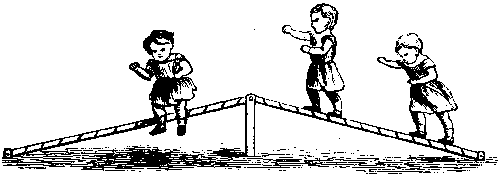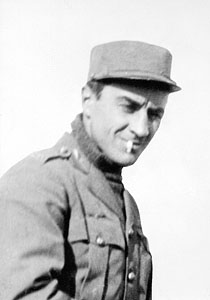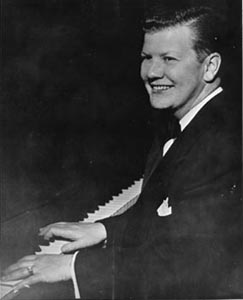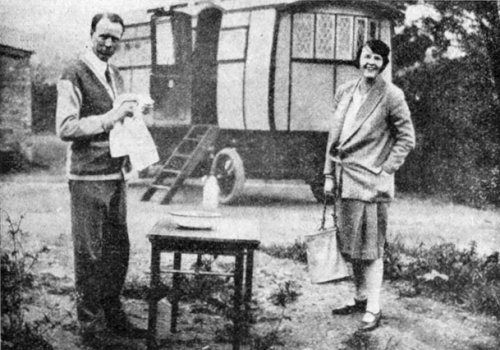
schoenobatist
funambulist
equilibrist
n. a tightrope walker

schoenobatist
funambulist
equilibrist
n. a tightrope walker
On July 12, 1942, someone shot Max Geller, the owner of Harlem’s Green Parrot Restaurant. The restaurant was locally famous for its namesake parrot, who had a useful vocabulary and could greet regular patrons by name.
No customer could identify the killer, and the agitated bird would cry only “Robber! Robber!” As the investigation foundered, someone suggested that perhaps it was saying “Robert! Robert!”
On the list of Geller’s regular customers detectives found a Robert Butler, a cab driver who had disappeared after the shooting. They traced him to the Bethlehem Steel plant in Baltimore, and he confessed: He’d shot Geller in a drunken rage for refusing to serve him. He was convicted in February 1944 and sentenced to 15 years.
He said, “I never did like that bird.”

This is James Norman Hall. He co-wrote Mutiny on the Bounty, operated a machine gun for the Royal Fusiliers, flew with the Lafayette Escadrille, and spent months as a German POW.
And he wrote the poetry of a 9-year-old girl.
Literally. In 1938 a girl came to Hall in a troubled dream and began dictating poems to him about life in his childhood home of Colfax, Iowa. “She told me things about people in our hometown that I had completely forgotten, or thought I had.”
He typed them up and published them under the title Oh, Millersville!, claiming they were the rediscovered work of a turn-of-the-century Iowa farmgirl named Fern Gravel:
Oh, it is wonderful in Millersville
On many a winter night,
When the ground is covered with snow
And the moon is shining so bright.
You can hear the sleigh-bells jingling
Everywhere around.
I don’t think there could be
A more beautiful sound.
Keats it ain’t, but its homely charm brought writeups in the New York Times and the Philadelphia Inquirer. Hall let six years elapse before he published a confession in the Atlantic Monthly, explaining that he’d been ruminating on the evils of industrialization when the girl’s voice had entered his thoughts. The voice, it seemed, remained: Hall wrote a dozen more books and moved to Tahiti, but in his autobiography he wrote that “Iowa, for all the years I have been away from it, has always been, and still is, home for me.”
For 25 years, Macalester College mathematician Joe Konhauser offered a “problem of the week” to his students. Here’s a sample, from the collection Which Way Did the Bicycle Go? (1996):
Fifteen sheets of paper of various sizes and shapes lie on a desktop, covering it completely. The sheets may overlap one another and may even hang over the edge of the desktop. Prove that five of the sheets can be removed so that the remaining ten sheets cover at least two-thirds of the desktop.

The Ghent altarpiece is 20-panel allegorical polyptych by Hubert and Jan van Eyck, a masterpiece of 15th-century art.
In April 1934, a thief stole the lower left panel and demanded a ransom of 1 million Belgian francs.
Seven months later, Flemish broker Arsène Goedertier collapsed after a speech at a political rally. He managed to say that he knew where the stolen panel was hidden, but he died before he could communicate the secret.
In Goedertier’s home police found abundant evidence that he had sent the ransom note, but there was no sign of the missing panel, only a record that it was “in a place where neither I nor anyone else can recover it without drawing attention.”
It remains missing to this day.
A Scholar traveyling, and having noe money, call’d at an Alehouse, and ask’d for a penny loafe, then gave his hostesse it againe, for a pot of ale; and having drunke it of, was going away. The woman demanded a penny of him. For what? saies he. Shee answers, for ye ale. Quoth hee, I gave you ye loafe for it. Then, said she, pay for ye loafe. Quoth hee, had you it not againe? which put ye woman to a non plus, that ye scholar went free away.
— John Ashton, Humour, Wit, & Satire of the Seventeenth Century, 1883

Jazz pianist Billy Tipton was biologically female. She lived as a man from age 19 to her death at 74, when the truth was discovered.
Born in 1914, Dorothy Tipton developed an early love of jazz, but sexism in the music industry and the straitened economy of the Depression made it impossible to find work. In 1933 she donned trousers and her father’s nickname and began playing in Oklahoma bars.
By the 1940s she was touring the country, and in the 1950s the Billy Tipton Trio released two albums for Tops Records and performed with Duke Ellington, Patti Page, and Rosemary Clooney. Arthritis finally forced Billy’s retirement in the 1970s.
Throughout all this Tipton had relationships with at least five women, including nightclub dancer Kitty Kelly, with whom she raised three adopted sons. She bound her chest, ostensibly to protect ribs fractured in an auto accident, and she always locked the bathroom door. Son William learned of his father’s sex only when a paramedic working on the dying Tipton asked, “Son, did your father have a sex change?”
Why keep a secret for 55 years? Tipton left no account of her reasons, and perhaps it’s none of our business. “I can’t say that passion wasn’t there with Billy, because it was,” said former lover Betty Cox, who insisted she never suspected Billy’s sex even during intimacy. “Now, 40 or 50 years later, you see these cross-dressers all the time on TV. You can certainly tell. Even on TV. I can look at a person and say, ‘Gee, that’s obviously a woman.’ Why couldn’t I then?”
You are grilling steaks for Genghis Khan. Your little grill can broil two steaks at a time, but Genghis is hungry and wants three. That’s a problem: It takes 4 minutes to grill each side of a steak, so you’ll spend 8 minutes grilling the first two steaks, then another 8 grilling the third. Sixteen minutes is a long time to keep a warlord waiting.
How can you improve your time while still cooking the steaks thoroughly? Genghis really likes his well done.

When Sinclair Lewis won the Nobel Prize in 1930, he began to receive fan mail. One young woman proposed becoming his secretary. “I’ll do everything for you,” she wrote. “And when I say everything, I mean everything.”
Lewis’ wife, Dorothy, saw the letter and responded. “My dear Miss,” she wrote. “My husband already has a stenographer who handles his work for him. And, as for ‘everything,’ I take care of that myself — and when I say everything, I mean everything.”